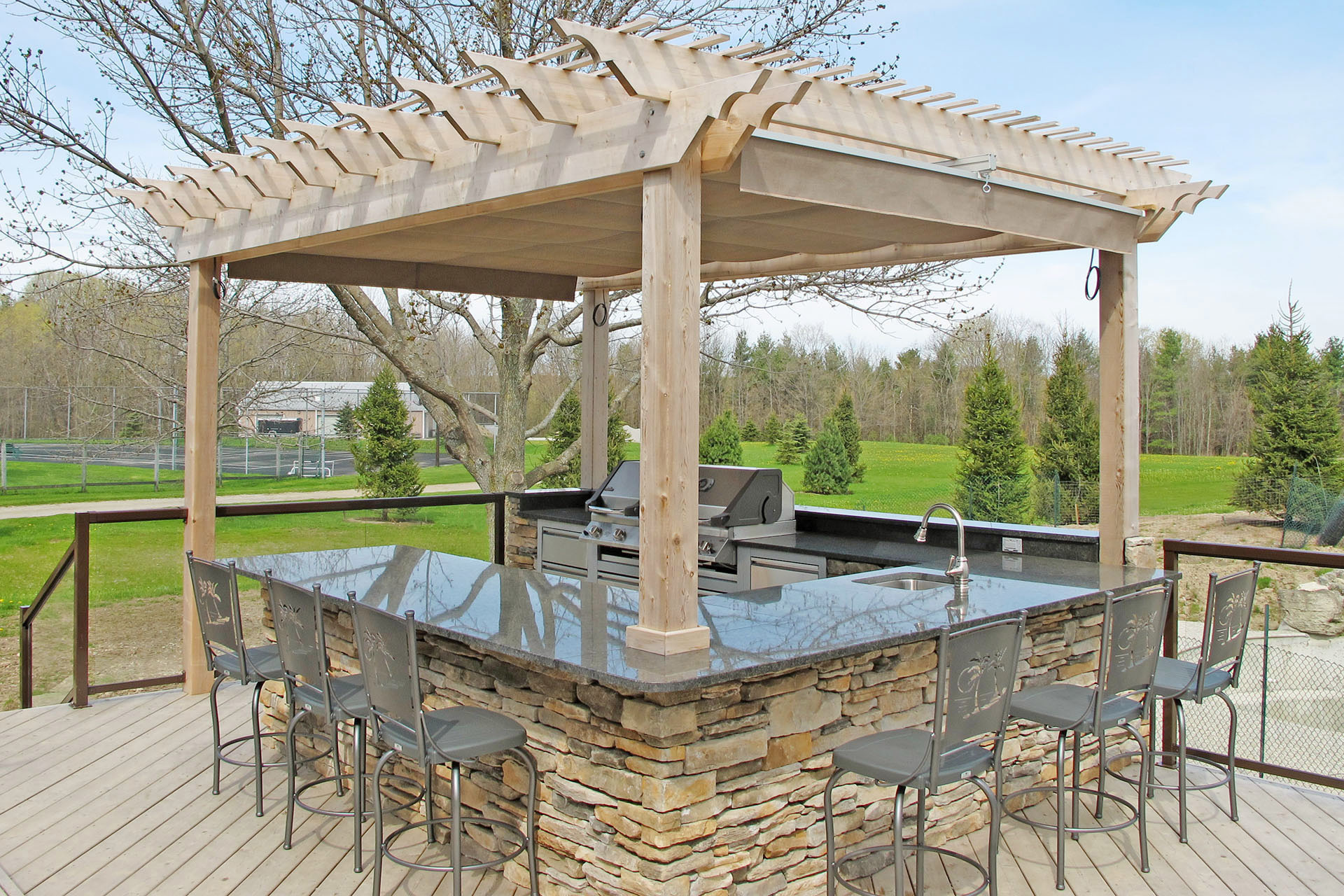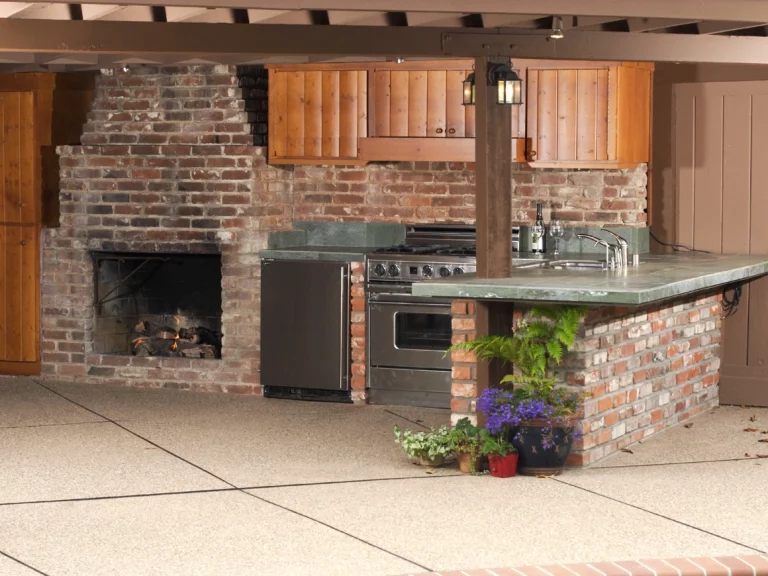An outdoor kitchen is not just a luxury; it’s a lifestyle choice that opens up new avenues for culinary exploration and social gatherings. However, with the beauty of al fresco cooking comes the challenge of weatherproofing, especially against the rain; you don’t want your beautifully decorated kitchen getting messed up because of the rain! Rainwater can be a formidable enemy to outdoor kitchens, potentially damaging appliances, furniture, and structures. Here’s a comprehensive guide on how to protect your outdoor kitchen during the rainy season, ensuring that your investment remains pristine and functional year after year.
Understanding the Risks
The allure of an outdoor kitchen is undeniable, offering a unique blend of nature, culinary delight, and social engagement. However, the outdoor setting also exposes your kitchen to the elements, with rain being one of the most significant threats. Understanding the specific risks associated with rain is crucial for implementing effective protective measures.

- Corrosion and Rust: Many outdoor kitchen components, including grills, burners, refrigerators, and other appliances, are metal that can corrode or rust when exposed to moisture over time. This affects the aesthetic appeal of these items and can compromise their structural integrity and functionality.
- Wood Damage: Wood elements, such as cabinets, decking, and furniture, are particularly susceptible to water damage. Rain can cause wood to warp, swell, and rot, requiring costly repairs and creating safety hazards.
- Mold and Mildew: Moisture from rain can create damp conditions ideal for mold and mildew growth. These can damage surfaces and structures and pose health risks to you and your family.
- Electrical Hazards: Outdoor kitchens often include electrical appliances and lighting. Rainwater can cause short circuits and other electrical issues, posing safety hazards and potentially damaging your appliances.
- Slippery Surfaces: Rain can make outdoor kitchen floors and surrounding areas slippery, increasing the risk of accidents and injuries.
Protecting Your Outdoor Kitchen The Right Way

1. Invest in Quality Covers
The first line of defense against the rain is high-quality, waterproof covers. These covers should be made from durable materials like polyester or vinyl to withstand harsh weather conditions. Look for covers with UV protection to prevent fading and degradation from sunlight.
Custom-fitted covers provide the best protection as they envelop each appliance snugly, leaving minimal gaps for water to seep through. While universal covers may offer a cost-effective alternative, they might not provide comprehensive protection against persistent rain.
2. Opt for Weather-Resistant Materials
When designing or upgrading your outdoor kitchen, selecting weather-resistant materials can make a difference in its longevity.
Granite, concrete, and stainless steel are excellent choices for countertops as they are durable and can withstand moisture without warping or staining. Marine-grade polymer and stainless steel cabinets resist rust and water damage, making them ideal for rainy climates. Wooden cabinets can be used, but ensure they are treated with a waterproof sealant.
Choose non-slip and water-resistant flooring materials like concrete, tiles, or composite decking to prevent accidents and water damage.
3. Implement a Roofing Solution
A permanent roofing structure over your outdoor kitchen can provide year-round protection from the elements. Pergolas with waterproof covers, metal roofs, or even retractable awnings can shield your kitchen from rain, sun, and debris. Ensure your roofing solution includes adequate ventilation to prevent smoke and heat buildup during cooking.
4. Ensure Proper Drainage
Water pooling can damage your outdoor kitchen’s foundation and lead to mold growth. Install a drainage system that directs water away from your kitchen area. Sloping floors slightly towards the drain can also prevent water accumulation.
5. Regular Maintenance and Cleaning
Routine maintenance can prevent long-term damage caused by rain. Regularly inspect your outdoor kitchen for signs of wear, rust, or water damage. Clean all surfaces, appliances, and covers to remove dirt, grease, and mildew.
Apply sealants to wood and stone surfaces to prevent water absorption. Check and maintain the integrity of your kitchen’s waterproofing measures, such as sealants and covers, before the rainy season begins.
6. Use Outdoor-Rated Appliances and Fixtures
Invest in appliances and fixtures specifically designed for outdoor use. These products are built to withstand various weather conditions, including rain, and will last longer than their indoor counterparts.
7. Electrical Safety
Ensure all electrical outlets and appliances are weatherproof and meet outdoor safety standards. Consider installing ground fault circuit interrupter (GFCI) outlets to protect against electrical shock in wet conditions.
8. Flexible Design Features
Implementing design features that can be adjusted based on the weather can greatly enhance the functionality of your outdoor kitchen. Consider installing retractable windscreens or side panels to provide additional protection during bad weather while allowing for open-air cooking when the weather is clear. Utilize portable cooking appliances that can easily move indoors or under cover when rain is imminent.
Conclusion
An outdoor kitchen represents a significant investment in your home’s value and your family’s quality of life. Protecting this investment from the rains is not just about preventing damage; it’s about ensuring the space remains a safe, functional, and enjoyable part of your home regardless of the weather. This guide has outlined several strategies, from selecting weather-resistant materials to implementing a robust maintenance routine to safeguard your outdoor kitchen from the elements.
The key to effective protection lies in understanding the specific risks posed by rain and addressing them proactively. Regular inspections and maintenance are crucial for identifying potential issues before they become serious problems. Investing in quality covers, considering weatherproof materials, and ensuring proper drainage are all measures that can significantly reduce the impact of rain.

